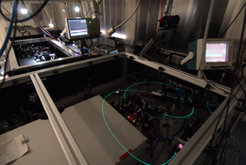Intense MHz-Rate coherent Extreme Ultraviolet Source
Project leader: Dr. Jens Rauschenberger
Project coordinator from King Saud University: Prof. Dr. Abdallah Azzeer
For some years now, researchers have produced coherent pulses in the extreme ultraviolet (XUV) spectral range by harmonic generation in gas targets. Being routinely generated these days, many great discoveries were thus achieved – ultimately opening up the research field attosecond physics.

Recently, however the concept of harmonic generation has been pushed a significant step forward: in order to improve on the low conversion efficiency in a single pass through the gas target, the idea of intra-cavity harmonic generation was proposed and realized in first proof-of-principle experiments. Placing the conversion target inside a resonator arrangement has several major benefits: (1) The high peak intensities (above 1013 W/cm2) required for nonlinear conversion can be reached without compromising on the pulse repetition rate. In conventional amplifier systems, the repetition rate is reduced to the kHz-range, whereas intra-cavity harmonic generation can exploit the full MHz repetition rate of the driving laser. (2) Due to the recycling effect of unconverted fundamental radiation in the resonator, significantly higher conversion efficiencies can be reached in this manner. (3) With the number of pulses per second being up to five orders of magnitude higher, also higher average powers in the XUV can be accomplished. (4) The setup is decisively less complex and costly than conventional amplifier systems.
Drawing on these key advantages, many applications in science and industry come into reach. Scientific applications may make use of the increased repetition rate of the XUV pulses. In the area of time-resolved spectroscopy, MHz repeating pulses allow for coincidence detection of ions and electrons. In this manner, ultimately, attosecond resolution can be married with the increased explanatory power of coincidence detection for the first time. In the area of high-precision frequency metrology, the increased spacing of the frequency comb allows for the extension of the frequency comb technique to the XUV spectral range, thus providing further verification of quantum electrodynamics.
However, also appealing applications in industry exist. Most prominently, the characterization of optical elements for XUV semiconductor lithography at 13 nm wavelength will be a key ingredient in the race towards ever smaller semiconductor structures and ever faster computers.
